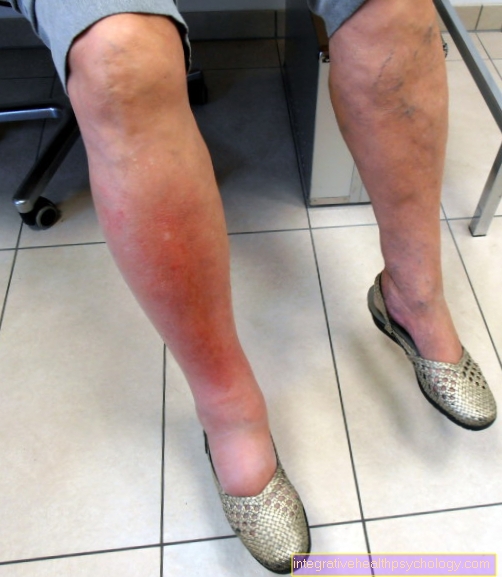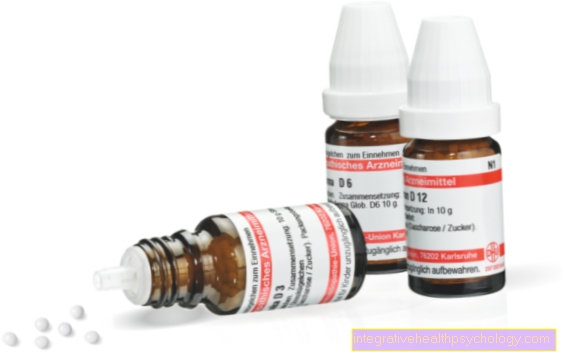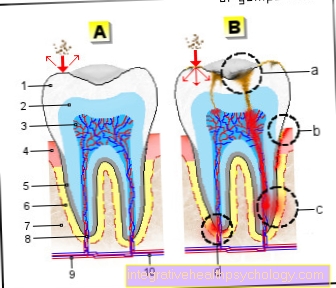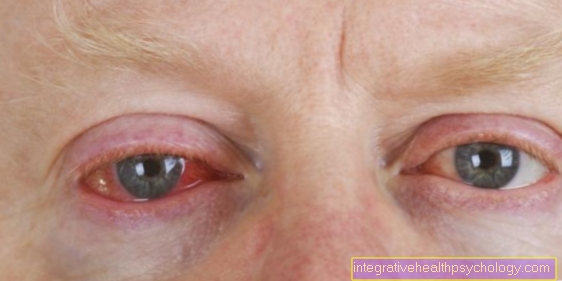Boils on the finger
definition
A boil is a bacterial inflammation caused by hair follicles.
A boil on the finger can be felt as a red, overheated, tender and hard knot. The surrounding tissue is also often affected.
If several boils lie next to each other on the finger and fuse together, a so-called carbuncle is created. If the finger furuncles appear again and again, the specialist speaks of a furunculosis.
Get general information about boils.

Causes of a finger furuncle
Injuries to the hairy skin of the fingers are a prerequisite for the development of a finger fur. Both larger injuries and tiny, inconspicuous damage to the skin can be the entry point for certain bacteria.
Finger furuncles can be triggered by various bacteria.
In most cases it is staphylococci. They are part of the normal skin flora and only under certain conditions do they cause bacterial inflammation and cause, for example, the development of a finger furuncle. They penetrate the injured skin along a hair follicle. After that, a deep inflammatory infiltration develops within a few hours to days.
An uncomplicated finger furuncle bursts on its own after about a week. This allows pus to escape and the finger furuncle is relieved. Then it usually heals on its own. Most of the time, a small scar remains.
Other possible causes of a finger furuncle are:
- Overuse of the skin of the fingers, in the form of pressure or friction
- Insufficient hand hygiene
- A weakened immune system
- Diabetes mellitus
- An iron deficiency anemia
In addition, the hands are exposed to chemical, mechanical and physical noxae and stimuli, as they are often in direct skin contact with these. This can quickly lead to minor damage and inconspicuous injuries to the skin of the fingers.
Learn more about the Causes of a boil.
Diagnosis of a finger furuncle
The diagnosis of a finger furuncle is a gaze diagnosis. The typical signs of inflammation appear:
- Redness
- Overheating
- swelling
- Pain on touch or pressure.
In some cases, a lighter color can be seen in the center of the boil. This marks the pus plug.
In addition, an anamnesis is important in order to be able to infer the possible causative factors. Particularly in the case of recurring finger fuzziness, the cause and, if necessary, the underlying underlying disease must be found out.
In some cases, a smear is taken to identify the pathogen.
If other diseases are the cause of recurring boils, further tests are carried out, such as measuring blood sugar and taking a blood sample in order to be able to measure certain parameters in the blood.
Symptoms of a finger fuzz
In addition to pain, redness, swelling and overheating, accompanying symptoms can also occur.
In the case of a finger furuncle, the finger functions can be restricted. Grasping, fine motor and graphomotor activities can be restricted and painful.
The pain may manifest as a feeling of tension or severe pain when touched and pressed.
When the finger furuncle bursts, pus comes out. This pus is usually yellowish and can leave an unpleasant odor.
Furthermore, there may be a general feeling of illness, fatigue, flu-like symptoms, fever and chills. A fever is a sign that the bacteria have entered the bloodstream. This creates a risk of blood poisoning. In this case, contact a doctor immediately.
Overall, complications with finger furuncles are rare. But when they do occur they show up with certain symptoms and it needs to be dealt with quickly. Emergency medical help is required in the event of drowsiness, shock or circulatory failure.
Do you suspect you may have developed blood poisoning? Learn more about the Symptoms of blood poisoning.
Therapy options
The treatment of finger furuncles depends on the size and individual factors. It is important that no self-treatment, in the sense of expressing the boil, is carried out. At best, the boil is not touched at all. Appropriate hand hygiene is the basis of the treatment of finger furuncles.
Moist heat and warm compresses help open a ripe boil. If the pus does not empty on its own, a stab incision may need to be made by a doctor in some cases. That means the finger furuncle has to be opened surgically. If there is an indication, it is usually a minor procedure. Often it can take place under local anesthesia. General anesthesia is only required in some cases.
Read more about Operation of a boil.
Antibiotic and antiseptic ointments are advisable for follow-up treatment. If the bacteria have already spread through the blood or lymphatic system, antibiotics must be taken orally for at least a week.
Get more information about the type and application of the Ointments for a boil.
It is also important to relieve the affected finger. The effect of Ichythyol cotton bandages is controversial. If the boils recur, the underlying disease must be treated. In addition, treatment with clindamycin and rifampicin (both antibiotics) is often carried out for 2-3 weeks and, if necessary, with vitamin C.
How long does it take to heal a finger furuncle?
The duration of a finger boil depends on the size, individual factors and the body's own immune system.
Small finger furuncles can heal in a few days. However, the prerequisites for this are:
- Good hygiene
- A well-functioning defense system
- The relief of the finger
In other cases, the healing process may take a few weeks.
With very unfavorable conditions and a corresponding size, the healing of a finger furuncle can take months.




























